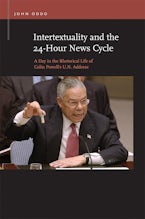On a cold Wednesday morning in February 2003 Colin Powell argued before the United Nations Security Council that Iraq harbored weapons of mass destruction. Before the speech, nearly 90 percent of Americans reported that Powell’s speech would help them determine their view about invading Iraq. In the days after the speech, a strong majority of Americans reported that they found Powell’s evidence convincing enough to justify war. But most American adults did not watch Powell’s speech. Instead, they learned about it from journalists—and to a large extent formed their opinions about war with Iraq based on news coverage of his address. In Intertextuality and the 24-Hour News Cycle John Oddo investigates the “rhetorical life” of Colin Powell’s address as it was extended across several media reports. Focusing on one day of pre- and postspeech news coverage, Oddo examines how journalists influenced Powell’s presentation— precontextualizing and recontextualizing his speech, and prepositioning and repositioning audiences to respond to it. The book surveys a variety of news media (television, newspaper, and Internet) and systematically integrates several methodological approaches (critical, rhetorical, discourse-analytic, and multimodal). This revealing text shows the decisive role that journalists played in shaping American attitudes about Powell, his presentation, and the desirability of war in Iraq.
ContentsList of TablesAcknowledgmentsNotational SchemeIntroduction. The Rhetorical Life of Colin Powell’s U.N. SpeechChapter One. The Campaign for War in Iraq: Contextualizing Powell’s Speech in Political and Media DiscourseChapter Two. The Chief Prosecutor and the Iraqi Regime: Intertextual Ethos and Transitive Chains of AuthorityChapter Three. Undercutting Saddam’s Denials: Precontextualization and Audience AlignmentChapter Four. America’s Best Intelligence: Recontextualization and Rhetorical TransformationChapter Five. Political Discourse, the Press, and the Public GoodAppendix A. Data CorpusAppendix B. Synoptic Views of DiscourseAppendix C. Intertextual Precedents for Powell’s ArgumentsAppendix D. Attitudinal Discourse in Linguistic and Multimodal TextsAppendix E. Attitudes about Powell and IraqAppendix F. Conventions of Precontextualizationin Mainstream JournalismAppendix G. The Engagement System, Temporality, and PresenceAppendix H. Coding Categories for Audience RepositioningAppendix I. A Four- Phased Analytic ApproachNotesBibliographyIndex

